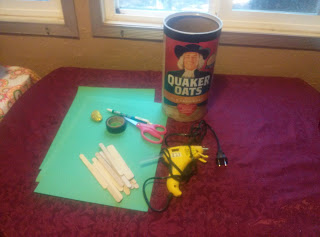One of my favorite family traditions is building a leprechaun trap with my kids each year for St. Patrick's Day. We've tried a lot of different designs over the years. Some have worked out better than others. In this post I share step-by-step instructions for one of my all time favorite traps, plus some ideas for other types of traps you can try.
-An empty oats container or an empty coffee can or another container of similar porportions.
-Several sheets of green construction paper
-Tape
-Scissors
-Popsicle sticks
-Hot glue gun
-Black marker
-Something to use as leprechaun bait (shinny pennies or lucky charms ceral work well)
If you enjoyed this post, check out:
5 Dr. Seuss Inspired Activities
Painted Rock Hunting
Follow me on:
Facebook
Pinterest
Instagram
How To Build A Leprechaun Trap:
For this project you will need:-An empty oats container or an empty coffee can or another container of similar porportions.
-Several sheets of green construction paper
-Tape
-Scissors
-Popsicle sticks
-Hot glue gun
-Black marker
-Something to use as leprechaun bait (shinny pennies or lucky charms ceral work well)
The trap we are making looks like a leprechaun's green top hat. First, trace the end of your container on a piece of green construction paper to make the top of your hat.
Trace another larger circle on another piece of green construction paper. This will become the brim of your leprechaun hat.
Cut out the green circles.
Set the circles aside for a few minutes and tape green construction paper around your oats or coffee container.
Next tape the larger circle on the bottom of your container to make the hat's brim.
Using the black marker, draw a black band above the hat's brim.
Next, set the hat aside and work on the ladder. Using the hot glue gun and popsicle sticks, build a ladder for the leprechaun to climb to the top of your hat trap.
Now your trap is ready to assemble. Place the small green construction paper circle carefully on the top (open end) of your hat. It should just barely sit over the edge of the container. Carefully set some leprechaun bait on top. Lean the ladder against the side, and that's it, your trap is finished. If a leprechaun climbs up on top to grab the bait, he should fall into the container. If you're lucky maybe he'll leave you a gold or chocolate coin.
To increase your chances of catching a leprechaun, you may want to decorate around your trap a little (or a lot). Leprechauns love all things St. Patrick's Day. Shamrocks, rainbows, anything green, anything gold, or anything shiny are all good choices for attracting leprechauns.
As I mentioned earlier, this is only one way to build a leprechaun trap. There are lots of other ways to do it. We've tried lots of different designs over the years. Be creative and search the web for inspiration. Below I'll share pictures of a few of our other traps.
Other Leprechaun Trap Ideas:
This was another one of my favorites, a little more complicated construction wise though. The little pot of gold is sitting on top of a string that is holding a colander disguised as a cloud above the pot. The idea here is when the leprechaun grabs the pot of gold the colander will fall and trap him (kind of like in the game Mouse Trap).
This was my daughter's trap she made last year and the first trap she designed and built entirely on her own. There was a hole cut in the top of the box and covered with construction paper for the leprechaun to fall through.
This is probably the most simple design there is. It's just a box held up with a stick. Place some bait inside and hopefully a leprechaun will knock over the stick and get trapped inside the box.
St. Patrick's Day will be here soon so gather up some supplies and get creative!
If you enjoyed this post, check out:
5 Dr. Seuss Inspired Activities
Painted Rock Hunting
Follow me on:

















Comments
Post a Comment